Aragonien |
|
|
|
| Übersicht – Contents: | |
Aragonien |
|
|
|
| Übersicht – Contents: | |
Flagge – Flag: |
|
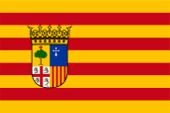 |
Flagge von Aragonien |
| historische und andere Flaggen – historical and other Flags: | |
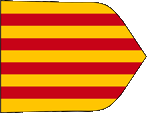 |
1150–1516, |
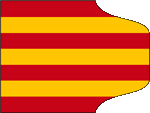 |
1263–1516, (?) |
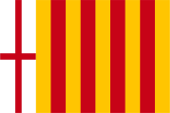 |
1977–1978, |
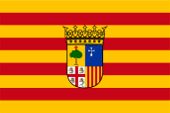 |
1978–1984, |
| Die heutige Flagge Aragoniens wurde am 28.06.1984 eingeführt. Sie zeigt vier horizontale rote Streifen auf goldenem Grund und in der Mitte das Wappen Aragoniens mit der aragonesischen Krone. Die Flagge mit ihren roten und goldenen Streifen geht auf die historische Heraldik Aragoniens und Kataloniens zurück. Das Wappenschild geht auf das 15. Jahrhundert zurück. Unter der der Regierung des Generals Franco (1936–1975) waren alle regionalen Flaggen verboten. Nach Francos Tod wurden die regionalen Flaggen wieder eingeführt, bzw. neue geschaffen. Aragonien nahm im Jahre 1977 eine Flagge mit vier roten senkrechten Streifen auf goldenem Grund an, mit einem zusätzlichen weißen Feld am Mast mit einem roten Kreuz, wenn auch zunächst inoffiziell, da Aragonien bis 1982 noch keinen Autonomiestatus hatte. Schon 1978 folgte eine neue Flagge, die bereits der heutigen ähnelte, das Wappen erschien in der Mitte der Flagge. Die ältesten Flaggen Aragoniens waren typische Wappenflaggen, die durch Drehung und Befestigung des Wappenbildes an einem Flaggstock entstanden sind. Bemerkenswert ist eine angeblich ab dem 13. Jahrhundert von Aragonien verwendete Marineflagge. Sie zeigt drei goldene Balken auf rotem Grund. Immerhin kann es sich um einen Beobachtungsfehler oder einen Fehler der durch falsches Abzeichnen entstanden ist handeln. Und Standards wie heute gab es damals nicht. |
The today's flag of
Aragon was introduced on 28th of June in 1984. It shows four horizontal red
stripes on a golden background and the coat of arms of Aragon with the
Aragonese crown in the centre. The flag with its red and golden stripes goes
back to the historical heraldry of Aragon and Catalonia. The escutcheon
dates back to the 15th century. Under the government of General Franco (1936-1975), all regional flags were banned. After Franco's death, the regional flags were reintroduced or new ones were created. Aragon adopted a flag with four red vertical stripes on a golden background in 1977, with an additional white field on the pole with a red cross, albeit unofficially at first, as Aragon did not have autonomous status until 1982. Already in 1978, a new flag followed, which already resembled the present one, the coat of arms appearing in the middle of the flag. The oldest flags of Aragon were typical armorial flags, created by rotating and attaching the coat of arms image to a flagpole. The naval flag used by Aragon from the 13th century onwards is remarkable because it shows three golden bars on a red background. Remarkable is a naval flag allegedly used by Aragon from the 13th century onwards. It shows three golden bars on a red background. After all, it could be an observation error or an error caused by incorrect marking. And standards like today did not exist back then. |
| Quelle/Source: Wikipedia (ES), Flags of the World, Volker Preuß | |
Wappen – Coat of Arms: |
|
 |
seit/since 1921, Wappen von Aragonien – coat of arms of Aragón, Quelle/Source, nach/by: Wikipedia (ES) |
historische Wappen – historical Coats of Arms: |
|
 |
11./12. Jhd./cent., legendäres Wappen von Aragonien – legendary coat of arms of Aragón, Quelle/Source, nach/by: Wikipedia (DE) |
 |
Wappen mit dem Kreuz von Alcoraz – coat of arms with the Cross of Alcoraz, Quelle/Source, nach/by: Wikipedia (DE) |
 |
12. Jhd./cent., Wappen der Grafschaft Barcelona – coat of arms of the County of Barcelona, Quelle/Source, nach/by: Wikipedia (DE) |
 |
ab 1150, Wappen der vereinigten Krone von Aragonien – coat of arms of the united crown of Aragón, Quelle/Source, nach/by: Wikipedia (DE) |
| Das heutige Wappen von Aragonien wurde am 16.04.1984 eingeführt, nachdem es bereits 1921 geschaffen worden war. Es geht auf ein Wappen des Königreichs Aragón aus dem 15. Jahrhundert zurück. Das spanische Königreich Aragón entstand, als König Sancho III. von Navarra (Sancho der Große) im Jahre 1035 sein Reich unter seine Söhne aufteilte. Sein Sohn Ramiro erhielt die alte Grafschaft Aragón und wurde als Ramiro I. erste König von Aragón. Aus dieser Frühzeit sind keine Wappen überliefert. Jedoch wird Ramiro ein blaues Wappen mit dem Kreuz des Íñigo Arista zugeschrieben, dass sich bis heute als ein Teil der Heraldik des Landes erhalten hat, genau so wie das Kreuz von Alcoraz, das auf König Peter I. zurückgeht. Dieses Wappen zeigte ein rotes Georgskreuz auf Silber und in den vier Feldern je einem sogenannten Mohrenkopf mit Augenbinde. Bei den Mohrenköpfen handelt es sich um die Köpfe von vier maurischen Königen, die im Jahre 1096 in der Schlacht von Alcoraz von König Peter I. besiegt und enthauptet wurden. Das rote Kreuz symbolisierte den christlichen Glauben. König Ramiro II. von Aragón setzte vor seinem Tod im Jahre 1137 seine neugeborene Tochter Petronella als Erbin ein, die im Jahre 1150 Raimund Berengar IV., den Grafen von Barcelona (Katalonien) heiratete. So entstand die vereinigte Krone von Aragonien unter dem Wappen von Raimund Berengar IV., die 1228–1232 um die Balearen und um 1238 noch um die Grafschaft Valencia erweitert wurde. Dieses Wappen zeigte vier senkrechte rote Balken auf Gold. Es geht auf ein Wappen zurück, das angeblich um 875 durch den westfränkischen König Karl der Kahle an den Wilfried den Behaarten, den damaligen Grafen von Barcelona übergeben worden war, weil er beim Kampf gegen die Mauren (Araber) Tapferkeit gezeigt hatte. Nach der Legende entstand es als ein Kämpfer die vier blutenden Finger seiner Hand durch das bis dahin gültige Wappen des Grafen zog. Die Farben Rot und Gold gehen aber angeblich auf den Einfluss des Papstes zurück, denn das alte Königreich Aragon und die Grafschaft Barcelona waren Lehen des Heiligen Stuhls. Rot und Gold sind die Farben der Stadt Rom. Nach der Vereinigung von Aragonien und Katalonien wurde die Heraldik von Katalonien für das ganze Land übernommen. Als Aragón Sardinien und kurzzeitig auch Korsika übernahm, wurden jedoch das Kreuz von Alcoraz bzw. einer der Mohrenköpfe als lokale Heraldik übernommen. |
The current coat of arms
of Aragon was introduced on 16th of April in 1984, after having been created in 1921.
It goes back to a coat of arms of the Kingdom of Aragón from the 15th
century. The Spanish Kingdom of Aragón came into being when King Sancho III of Navarre (Sancho the Great) divided his kingdom among his sons in 1035. His son Ramiro received the old county of Aragón and became the first king of Aragón as Ramiro I. No coats of arms have survived from this early period. However, Ramiro is credited with a blue coat of arms with the cross of Íñigo Arista, which has survived to this day as part of the country's heraldry, as has the cross of Alcoraz, which goes back to King Peter I. This coat of arms showed a red St George's cross on silver and in each of the four fields a so-called Moor's head with an eye-patch. The Moor's heads are the heads of four Moorish kings who were defeated and beheaded by King Peter I in the Battle of Alcoraz in 1096. The red cross symbolised the Christian faith. Before his death in 1137, King Ramiro II of Aragon appointed his newborn daughter Petronella as heiress, who married Raimund Berengar IV, Count of Barcelona (Catalonia) in 1150. Thus was born the united Crown of Aragon under the arms of Raimund Berengar IV, which was extended to include the Balearic Islands in 1228–1232 and the county of Valencia in 1238. This coat of arms showed four vertical red bars on gold. It goes back to a coat of arms that was supposedly given to Wilfried the Hairy, then Count of Barcelona, around 875 by the West Frankish King Charles the Bald, because he had shown bravery in the fight against the Moors (Arabs). According to legend, it was created when a fighter drew the four bleeding fingers of his hand through the count's coat of arms, which had been in use until then. The colours red and gold, however, supposedly go back to the influence of the Pope, because the old kingdom of Aragon and the county of Barcelona were fiefdoms of the Holy See. Red and gold are the colours of the city of Rome. After the union of Aragon and Catalonia, the heraldry of Catalonia was adopted for the whole country. However, when Aragon took over Sardinia and briefly Corsica, the cross of Alcoraz or one of the Moor's heads were adopted as local heraldry. |
| Quelle/Source: Wikipedia (ES), Wikipedia (DE), Volker Preuß | |
|
Die autonomen Regionen Spaniens – The autonomous Regions of Spain: Interaktive Landkarte - interactive map |
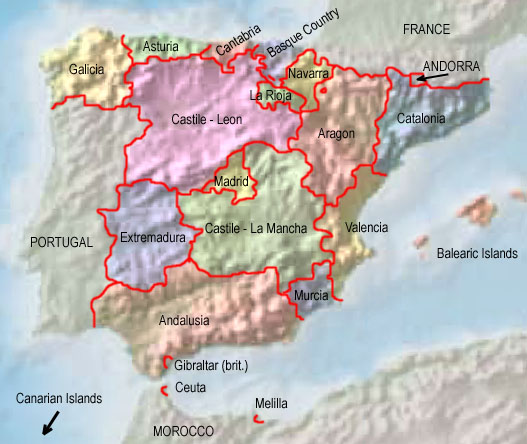 |
| Quelle/Source: Freeware, University of Texas Libraries, modyfied by: Volker Preuß |
|
Karte der historischen Königreiche auf der Iberischen Halbinsel (ca. 1220) – Map of the historical Kingdoms on the Iberian Peninsula (ca. 1220): Interaktive Landkarte - interactive map |
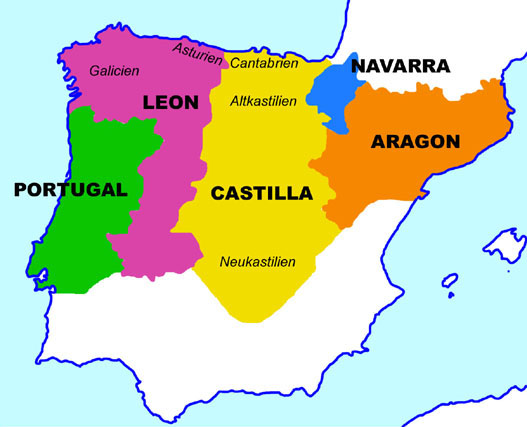 |
| Landkarte/map by: Volker Preuß |
| Zahlen und Fakten – Numbers and Facts: | |
|
|
|
|
|
|
|
|
|
|
|
|
|
|
|
|
|
Frühzeit
· Besiedlung durch Iberer ca. 600 v.Chr. · Einwanderung von Kelten, Vermischung mit den Iberern, Herausbildung der Keltiberer 218–201 v.Chr. · Zweiter Punischer Krieg, das Römische Reich erwirbt die Besitzungen Karthagos in Iberien, Unterwerfung der ganzen Iberischen Halbinsel bis zum Jahre 19 v.Chr., römische Besiedlung, Romanisierung, das heutige Aragonien kommt zur römischen Provinz Hispania Tarraconensis ca. 400 n.Chr. · Völkerwanderung, Durchzug von Alanen, germanischen Sweben und Westgoten 415 · zum Westgotenreich 711–714 · Vernichtung des Westgotenreichs durch von Nordafrika kommende Araber 714 · die Araber erobern Aragonien 778 · das Frankenreich unter Karl dem Großen erobert Aragonien, Errichtung der Spanischen Mark im Pyrenäenvorland, jedoch Niederlage gegen die Basken im Tal von Ronceval 795–812 · Wiedererrichtung der Spanischen Mark durch Karl den Großen und Ludwig den Frommen, dem Sohn von Karl dem Großen ca.820–ca.880 · Krise des Frankenreichs nach dem Tod von Karl dem Großen, Aufteilung des Reiches, Erbfolgestreitigkeiten, in der Spanischen Mark werden die fränkischen Markgrafen vertrieben und durch gewählte lokale Dynastien ersetzt, in Aragonien ist dies nicht der Fall, es erfolgt die Wahl von Graf Azenar, Sohn von Eudo, dem Herzog von Aquitanien zum Grafen von Aragonien, der sich jedoch vom Fränkischen Reich unabhängig machte 905–925 · Expansion des benachbarten Königreichs Navarra ca.1000 · Aussterben der Grafen von Aragonien, das Erbe fällt an das Königreich Navarra 1001–1035 · Regierungszeit von Sancho III. von Navarra (der Ältere, der Große), nach seinem Tod wird das Königreich unter seine vier Söhne aufgeteilt: Garcia wird König von Navarra, Ferdinand wird König von Kastilien, Ramiro wird König von Aragonien, Gonzales wird König von Ribagorza-Sobrarbea ca.1040–1060 · Ramiro I. von Aragonien erwirbt Ribagorza und Sobrarbe, triumphiert mehrfach über die Moslems und wird zum König gekrönt 1063–1104 · Herrschaft der Könige Sancho Ramirez und Pedro, Befreiung weiterer Territorien von den Moslems 1104–1134 · Herrschaft von König Alfons I. 1109 · Alfons I. heiratet eine Tochter von König Alfons VI. von Kastilien (Vereinigung von Aragonien und Kastilien) 1118 · Alfons I., König von Aragonien, erobert Saragossa (Zaragoza) und macht es zur Hauptstadt, Befreiung von Tarragona von den Moslems 1134 · Tod von König Alfons I., in seinem Testament hinterlässt er sein Reich den geistlichen Ritterorden der Reconquista, jedoch wird sein letzter Wille von den Ständen Aragoniens ignoriert, der Bruder von Alfons I., wird als Ramiro II. zum König gewählt, Kastilien wird wieder selbstständig 1137 · Ramiro II., König von Aragonien, verlobt seine Tochter Pedronella mit Raimund Berengar IV., dem Grafen von Barcelona (Katalonien) 1150 · Hochzeit von Pedronella und Raimund Berengar 1162 · Alfons II., Sohn von Raimund Berengar wird Graf von Barcelona 1163 · Alfons II. wird König von Aragonien (damit Vereinigung von Aragonien und Katalonien) 1172 · Aragonien erwibt die Grafschaft Roussillon und die Cerdagne (zeitweise auch Montpellier und Carcassonne) 1196–1213 · Herrschaft von König Pedro II. 1213–1276 · Herrschaft von König Jakob I. 1228–1232 · Aragonien erwibt die Balearen 1238 · Befreiung von Valencia von den Moslems 1248 · Befreiung von Alicante von den Moslems 1276–1285 · Herrschaft von König Peter III. 1282 · Aragonien erwibt Sizilien („Sizilianische Vesper”, Vertreibung der Anjou aus Palermo), Krieg mit Frankreich 1283 · Steuererhöhung, die Stände von Aragonien erzwingen vom König das Generalprivilegium von Saragossa 1285–1291 · Herrschaft von König Alfons III., Kriege mit Kastilien und Frankreich, die Stände werden stärker 1291–1327 · Herrschaft von König Jakob II., dem Bruder von Alfons III. 1326 · Aragonien erwibt Sardinien 1319 · die Unteilbarkeit des Reiches (Erbteilung) wird gesetzlich festgeschrieben, weiterhin eigene Ständeversammlungen (Cortes) in Katalonien und Valencia 1327–1336 · Herrschaft von König Alfons IV., dem Sohn von Jakob II., Kriege im Bündnis mit Kastilien gegen Genua und die Araber 1336–1387 · Herrschaft von König Peter IV., dem Sohn von Alfons IV., Ende des Krieges gegen Genua, teilweiser Verlust von Sardinien, Krieg gegen Kastilien, Bruderkrieg gegen die anderen Söhne von Alfons IV., die Stände werden stärker 1387–1395 · Herrschaft von König Johann, dem Sohn von Peter IV., Verlust von Sardinien 1410 · Tod von König Martin, dem Bruder von Johann, Aussterben der Dynastie Ramiros von Navarra 1410–1412 · Thronstreitigkeiten, per Schiedsspruch wird Ferdinand I. von Kastilien, ein Neffe von König Johann, König von Aragonien 1412–1416 · Herrschaft von König Ferdinand I. 1416–1458 · Herrschaft von König Alfons V., dem Sohn von Ferdinand I., Regentschaft durch seine Gemahlin Maria von Kastilien und seinem Bruder Johann, Alfons V. erobert das Königreich Neapel (1442) vom Haus Anjou und vereinigt Neapel und Sizilien mit Aragonien, Konflikte mit Frankreich 1458 · Tod von Alfons V., sein Sohn Ferdinand wird König in Neapel, sein Bruder Johann II. wird König von Aragonien (verheiratet mit Blanka von Navarra, somit auch König von Navarra, Abtretung des Roussillon an Frankreich 1479 · Tod von König Johann II., Nachfolger wird sein Sohn Ferdinand II. 1469 · Heirat von Isabella I., Königin von Kastilien-León und Ferdinand II., dem Prinzen und Thronfolger von Aragonien 1479 · Krönung von Ferdinand II. und Isabella I. zu Königen von Spanien 1516 · offizielle Vereinigung von Aragonien und Kastilien, Aragonien behält jedoch wichtige Privilegien 1609 · König Philipp III. von Spanien verweist die letzten Moslems (Morisken) des Landes 1701–1714 · Spanischer Erbfolgekrieg, Aragonien ergreift für Östrereich Partei, nach der Niederlage Verlust der Privilegien, Ende des selbstständigen Königtums der Vereinigten Krone von Aragonien, Katalonien, die Balearen und Valencia werden ausgegliedert, Aragonien (in seinen heutigen Grenzen), und Valencia behalten nominell den Titel eines Königreichs, Katalonien wird nominelles Fürstentum Barcelona 1808–1813 · Aragonien ist durch französische Truppen besetzt 1833 · die bis dato in Spanien bestehenden Teilkönigreiche und Regionen werden in Provinzen aufgeteilt, das Königreich Aragonien in die Provinzen Huesca, Zaragoza und Teruel 1936–1939 · Spanischer Bürgerkrieg, Aragonien kämpft bis 1939 teilweise auf Seiten der sozialistischen Regierungstruppen, in Katalonien hält sich eine "Anarchistenrepublik" bis zur Zerschlagung durch die sozialistischen Regierungstruppen 1978 · vorläufiges Autonomiestatut für Aragonien 10.08.1982 · (nach anderen Quellen 16.08.1982) Aragonien erhält das Autonomiestatut innerhalb Spaniens (unter Zusammenfassung der Provinzen Huesca, Zaragoza und Teruel), Gründung der "Autonomen Gemeinschaft Aragonien" 07.05.1992 · Neufassung des Autonomiestatuts, Vergrößerung der Autonomierechte von Aragonien |
|
early ages
· settlement by Iberians ca. 600 B.C. · immigration of Celts, mix with the Iberians, evolution of the Celtiberians 218–201 B.C. · Second Punic War, the Roman Empire acquires the possessions of Carthago in Iberia, subjugation of whole Iberia until the year 19 B.C., Roman settlement, romanization, the today’s Aragon comes to the Roman province of Hispania Tarraconensis ca. 400 A.D. · Great Transmigration (Migration Period), immigration of Alans, teutonic Suebs and Western Goth 415 · to the Empire of the Western Goth 711–714 · annihilation of the Empire of the Western Goth by from northern Africa coming Arabs 714 · the Arabs conquer Aragon 778 · the Frankish Empire under Carl the Great conquers Aragon, establishment of the Spanish Mark in the foreland of the Pyrenees Mountains, but defeat against the Basques in the Valley of Ronceval 795–812 · re-establishment of the Spanish Mark by Carl the Great and his son Ludvig the Pious ca.820–ca.880 · crisis of the Frankish Empire after the death of Carl the Great, sharing out of the empire, succession quarrels, the Frankish margrave become banished in the Spanish Mark and were substituted by elected local dynasties, but not in Aragon, there was elected Count Azenar to the Count of Aragon, the son of Eudo Duke of Aquitania, which made itself independent from the Frankish Empire 905–925 · expansion of the neighbouring Kingdom of Navarra ca.1000 · vanish of the Counts of Aragon, the heritage comes to the Kingdom of Navarra 1001–1035 · times of the rule of Sancho III. of Navarra (the Elder, the Great), after his death the kingdom becomes shared under his four sons: Garcia becomes king of Navarra, Ferdinand becomes king of Castile, Ramiro becomes king of Aragonia, Gonzales becomes king of Ribagorza-Sobrarbe ca.1040–1060 · Ramiro I. of Aragon acquires Ribagorza and Sobrarbe, triumphs severally over the Muslims and becomes crowned to king 1063–1104 · times of the rule of the kings Sancho Ramirez and Pedro, liberation of further territories from the Muslims 1104–1134 · times of the rule of king Alfons I. 1109 · Alfons I. marrys a daughter of king Alfons VI. of Castile (unification of Aragon and Castile) 1118 · Alfons I., king of Aragon, conquers Saragossa (Zaragoza) and makes it to capital, liberation of Tarragona from the Muslims 1134 · death of king Alfons I., in his testament he bequeathes his empire to the clerical knight orders of the reconquista, but his last will becomes ignored by the estates of Aragon, the brother of Alfons I., becomes elected to king as Ramiro II., Castile becomes independent again 1137 · Ramiro II., King od Aragon, engages his daughter Pedronella with Raimund Berengar IV., the Count of Barcelona (Catalonia) 1150 · wedding of Pedronella and Raimund Berengar 1162 · Alfons II., son of Raimund Berengar becomes Count of Barcelona 1163 · Alfons II. becomes king of Aragon (in this way unification of Aragon and Catalonia) 1172 · Aragon acquires the County of Roussillon and the Cerdagne (momentary even Montpellier and Carcassonne) 1196–1213 · times of the rule of king Pedro II. 1213–1276 · times of the rule of king Jakob I. 1228–1232 · Aragon acquires the Balearic Islands 1238 · liberation of Valencia from the Muslims 1248 · liberation of Alicante from the Muslims 1276–1285 · times of the rule of king Peter III. 1282 · Aragon acquires Sicily Island („Sicilian Vespers”, expulsion of the house of Anjou out of Palermo), war with France 1283 · increase of tax, the estates of Aragon compel from the king the General Privilege of Saragossa 1285–1291 · times of the rule of king Alfons III., wars with Castile and France, the estates become stronger 1291–1327 · times of the rule of king Jacob II., the brother of Alfons III. 1326 · Aragon acquires Sardinia Island 1319 · the non-divisibility of the empire (sharing out because of heritage) becomes fixed by law, furthermore own corporate assemblys (Cortes) in Catalonia and Valencia 1327–1336 · times of the rule of king Alfons IV., the son of Jacob II., wars in alliance with Castile against Genua and the Arabs 1336–1387 · times of the rule of king Peter IV., the son of Alfons IV., end of the war against Genua, partial loss of Sardinia, war against Castile, brother war against the other sons of Alfons IV., the estates become stronger 1387–1395 · times of the rule of king Johann, the son of Peter IV., loss of Sardinia 1410 · death of King Martin, the brother of Johann, vanish of the dynasty of Ramiro of Navarra 1410–1412 · throne quarrels, by arbitrage becomes Ferdinand I. of Castile – a nephew of king Johann - king of Aragon 1412–1416 · times of the rule of king Ferdinand I. 1416–1458 · times of the rule of king Alfons V., the son of Ferdinand I., regency by his consort Maria of Castile and his brother Johann, Alfons V. conquers the Kingdom of Naples (1442) from the house of Anjou and unites Naples and Sicily with Aragon, conflicts with France 1458 · death of Alfons V., his son Ferdinand becomes king in Naples, his brother Johann II. becomes king of Aragon (married with Blanca of Navarra, in this way even king of Navarra, ceding of the Roussillon to France 1479 · death of king Johann II., successor is his son Ferdinand II. 1469 · marriage of Isabella I., Queen of Castile-Leon and Ferdinand II., the Prince and Throne-Successor of Aragon 1479 · coronation of Ferdinand II. and Isabella I. to kings of Spain 1516 · official unification of Aragon and Castile, but Aragon withholds important privileges 1609 · king Philipp III. of Spain banishes the last Muslims (Moresques) out of the country 1701–1714 · Spanish succession war, Aragon positiones itself at the side of Austria, after the defeat loss of the privileges, end of the independent kingship of the United Crown of Aragon, Catalonia, the Balearic Islands and Valencia become outsourced, Aragon (in its today’s borders) and Valencia withhold nominally the title of a kingdom, Catalonia becomes nominally the Principality of Barcelona 1808–1813 · Aragon is occupied by French troops 1833 · the until that point in time in Spain existing partial kingdoms and regions become divided in provinces, the Kingdom of Atagon in the provinces of Huesca, Zaragoza and Teruel 1936–1939 · Spanish Civil War, Aragon fights until 1939 partially on the side of the socialistic governmental troops, in Catalonia exists an "Anarchist Republic" until the conquest by the socialistic governmental troops 1978 · temporary autonomy statute for Aragon 10th of August 1982 · (by other sources 16th of August 1982) Aragon gets the statute of autonomy within Spain (by summary of the provinces of Huesca, Zaragoza and Teruel), establishment of the "Autonomous Community of Aragon" 7th of May 1992 · revision of the autonomy statute, enlargement of the autonomy rights of Aragon |
| Quelle/Source: Wikipedia (ES), World Statesmen, RetroBib Retrobibliothek, Volker Preuß |
| Der Name "Aragonien" geht auf den Fluss "Aragón" zurück, einem Nebenfluss des Ebro. Wahrscheinlich haben die Westgoten dem Fluss seinen Namen gegeben, denn in "Aragón" verbirgt sich die Silbe "ah" bzw. "aha", das altgermanische Wort für "Wasser". | The name
"Aragon" goes back to the River "Aragón", a affluent of Ebro River. Probably the Western Goth gave the river its name, because in "Aragón" is hidden the syllable "ah" resp. "aha", the ancient teutonic word for "water". |
| Quelle/Source: Handbuch der geographischen Namen | |